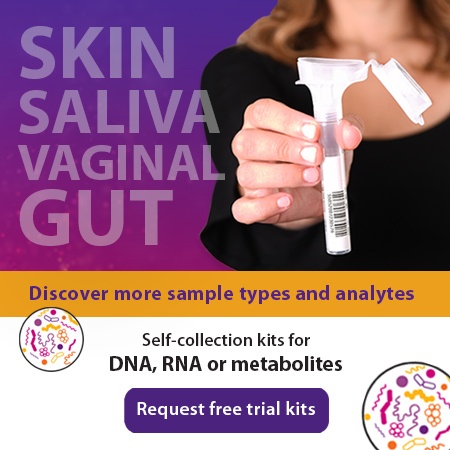2015-02-18
One of the most critical components of studying the microbiome is ensuring you have a profile that is representative of the microbial community present in the donor. The reality of microbiome research, and any research for that matter, is that a variety of factors can impact the quality of your sample and its microbial community and thus, the quality of your data. Assume for example, that the microbial profile resembles Diagram “A” when in the in vivo state. The goal is to minimize any potential source of variability so that your sample accurately reflects that of the in vivo state (Diagram B) rather than an “ex vivo” artefact (Diagram C). Think of it like this: you could take a “snapshot” of the microbial community at the time of collection, preserve it through the analysis and generate an accurate microbiome profile.
So, why is it so important to preserve a profile and what might a researcher be looking for in that profile? In the microbiome field, it is important to take a full inventory of the microbial community. This will uncover what types of bugs are present and their diversity. Does the diversity of bug types, also known as “richness”, tell us anything about one’s state of health or disease? Likewise, does the absence or presence of certain bugs tell us anything about health status or potential therapeutic interventions? A study by Le Chatelier et al. concluded that individuals with a low bacterial richness are characterized by more marked overall adiposity, insulin resistance and dyslipidamia and a more pronounced inflammatory phenotype when compared with high bacterial richness individuals[i]. This example shows how richness of the microbial profile or lack thereof, helps researchers to look at the impact of changes in the bug population. The richness of a microbial community is highly susceptible to environmental conditions including temperature, PH, oxygen concentration and chemical composition[ii].
Richness of a microbial profile is an important concept that goes hand in hand with abundance. Now that we know what types of bugs are in the profile, it is also critical to assess the number of each bug type in the sample. Does each type of bug have similar representation or are there, for example, three types of bugs that predominate the profile and fifty types that have limited representation? Are the three predominant bugs critical in determining the state of obesity or is it the rare bug type that provides critical information about one’s health or disease? A recent study by Zhou Y. et al, demonstrates a link between diversity and abundance of a profile in relation to disease, “The microbiome of healthy participants was influenced by age and season of sample collection with increased richness and diversity seen in younger participants and in samples collected during the dry season. Decreased diversity and an increased abundance of Corynebacterium and Streptococcus were seen in participants with conjunctival scarring compared to normal controls.[iii]”

Now if you consider richness (diversity of bug types/unweighted inventory) and abundance (amount of each bug type/weighted) it becomes more obvious why it is important for a researcher to ensure that each sample captures and preserves the profile of the microbial community immediately at the moment of collection. It is accepted in the microbiome field that an “unstabilized” sample will change its microbial profile when subjected to time and environmental sources of variability such as temperature fluctuations, transport conditions and freeze-thaw cycles. For example, Sergeant et al. showed that “the number of freeze-thaw cycles has been reported to have an effect on the composition of the microbial community.[iv]” In terms of “richness”, unstabilized samples run the risk of bug types being eliminated from the profile or alternatively some bugs might start to grow altering the results. With respect to abundance, if an unstabilized profile changes, you could risk artificially modifying the relative abundance of certain bugs, masking meaningful differences in the profile and increasing the complexity of the analysis and validation of biomarkers. The unfortunate reality of this profile change is that a researcher would not even know that his/her hypothesis is based on an experimental artefact. Even when DNA extraction, library prep, sequencing and analysis are done following the strictest of protocols, an inadequate sample can result in a wrong conclusion. In a nutshell, if the profile is not a proper representation of the in vivo state, the researcher will miss valuable pieces of information, impact the differences found between cases and controls, and in the worst case, publish based on an artefact.
The importance of ‘snapshoting’ or stabilizing the microbial profile as the goal for a reliable representation of the in vivo profile has been established. Now let’s take a look at the factors that can play a role in negatively impacting a sample, also known as sources of variability of the microbial profile.
A major source of variability in the microbial profile emerges during sample collection and handling; including exposure to a wide range of temperatures and transport conditions. Depending on the location of study participants and the lab, a sample can be exposed to time, extreme temperatures, fluctuations of temperature and freeze-thaw cycles due to shipping delays. A study by Cardona, S et al stated that storing fecal samples at room temperature over 3 hours after collection or allowing them to thaw and refreeze is not recommended for shotgun metagenomic sequencing, since DNA extracted from these samples can be significantly fragmented[v]. Consider the example of your laboratory (facility “A”) that wants to replicate a microbiome study that was completed by one of your collaborators (facility “B”). In order to reproduce the research results, lab “A” will need to follow standardized methods and protocols detailed in the study completed by facility “B”. The ability to standardize methods as much as possible will enable facility “A” to reproduce facility “B’s” study. The research community’s thinking over the past few years has evolved to identify the need to stabilize a sample even for short term storage and standardize methods as much as possible to achieve quality results. Choices made from study design through to analysis can impact results. Biological variability for example, can occur if fecal samples are collected from different geographic regions, age ranges and from people with different habits. This intrinsic variability can certainly increase the complexity of studying microbial communities; however, a careful study design can minimize the impact of such variables, resulting in meaningful contributions to the scientific community. It is widely recognized that laboratory methods (i.e. PCR, extraction and sequencing) also introduce some changes to the profile (known as technical variability) but the impact on the interpretation of the results is negligible.
As an example, OMNIgene●GUT* is a device for the collection of microbial DNA from feces that can both standardize and stabilize a sample such that it immediately captures the microbial profile at the time of collection and preserves it to eliminate degradation or microbial growth. In a recent white paper titled “OMNIgene●Gut stabilizes the microbiome profile at ambient temperature for 14 days and during transport”, there was no significant difference between OMNIgene●GUT samples stored at room temperature for 14 days and -80°C samples, when compared to fresh samples. Unstabilized samples however, showed significant dissimilarity when compared to either -80°C control or OMNIgene●GUT.

“As the microbiome field matures and technology further develops, improvements and standardization of microbiome research are expected.[i]” Standardization will be required for quality data in multicentre research studies needing to minimize sources of variability and reproduce results.
References:
[i] Goodrich, Julia K et al. Conducting a Microbiome Study. Cell. 158, Jul 17, 2014.
[i] Le Chatelier, E et al. Richness of human gut microbiome correlates with metabolic markers. Nature. 500. 541-549.
[ii] Doukhanine, E et al. OMNIgene●GUT enables reliable collection of high quality fecal samples for gut microbiome studies. www.dnagenotek.com PD-WP-0040 1/2014-09.
[iii] Zhou Y, et al. (2014) The conjunctival microbiome in health and trachomatous disease: a case control study. Genome Medicine, 6:99.
[iv] Sergeant, M.J. et al. (2012). High-throughput sequencing of 16S rRNA gene amplicons: effects of extraction procedure, primer length and annealing temperature. PLoS ONE 7 e38094.
[v] Kennedy N et al. 2014, The impact of different DNA extraction kits and laboratories upon the assessment of human gut microbiota composition by 16S rRNA gene sequencing. Plos ONE 9 (2).


